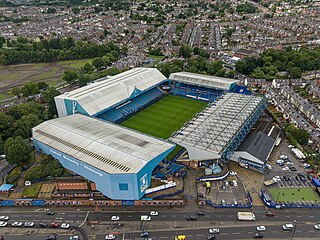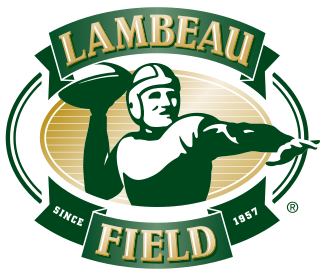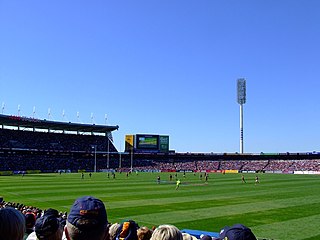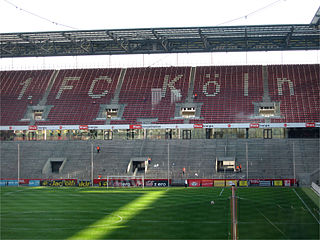Related Research Articles

Hillsborough Stadium is a football stadium in Sheffield, England. It has been the home of Sheffield Wednesday since opening in 1899.

Lambeau Field is an American football outdoor multi-purpose stadium in Green Bay, Wisconsin. The home field of the Green Bay Packers of the National Football League (NFL), it opened 67 years ago in 1957 as City Stadium, replacing the original City Stadium at Green Bay East High School as the Packers' home field. Informally known as New City Stadium for its first eight seasons, it was renamed in August 1965 in memory of Packers founder, player, and long-time head coach, Earl “Curly” Lambeau, who had died two months earlier.

A stadium is a place or venue for (mostly) outdoor sports, concerts, or other events and consists of a field or stage either partly or completely surrounded by a tiered structure designed to allow spectators to stand or sit and view the event.

Lincoln Financial Field is an American football stadium in Philadelphia, Pennsylvania. It is the home stadium of the Philadelphia Eagles of the National Football League (NFL) and the Temple Owls football team of Temple University. The stadium is located in South Philadelphia on Pattison Avenue between 11th and South Darien streets alongside I-95. It is part of the South Philadelphia Sports Complex and has a seating capacity of 67,594.

Football Park, known commercially as AAMI Stadium, was an Australian rules football stadium located in West Lakes, a western suburb of Adelaide, the state capital of South Australia, Australia. It was built in 1973 by the South Australian National Football League (SANFL) and opened in 1974. Until the end of the 2013 AFL season, it served as the home ground of South Australia's AFL clubs, the Adelaide Football Club and Port Adelaide Football Club. It also hosted all SANFL finals from 1974 to 2013. Demolition of the stadium's grandstands began in August 2018, and finished in March 2019.

Ibrox Stadium is a football stadium on the south side of the River Clyde in the Ibrox area of Glasgow, Scotland. The home of Scottish Premiership team Rangers Football Club, Ibrox is the third largest football stadium in Scotland, with an all-seated capacity of 50,817. The stadium was designed by renowned football stadium architect Archibald Leitch, with renovations to the stadium between 1978 and 1981, as well as 1990 and 1991, being designed by The Miller Partnership and Gareth Hutchison respectively.
The Hillsborough Stadium Disaster Inquiry report is the report of an inquiry which was overseen by Lord Justice Taylor, into the causes of the Hillsborough disaster in Sheffield, South Yorkshire, England, on 15 April 1989, as a result of which, at the time of the report, 95 Liverpool fans had died. An interim report was published in August 1989, and the final report was published in January 1990.

The Philips Stadion is a football stadium in Eindhoven, Netherlands. As the home of PSV Eindhoven, it is therefore also known as PSV Stadion. With a capacity of 36,500, it is the third-largest football stadium in the country. Established as the Philips Sportpark, it was constructed as a sports field for Philips employees in 1910. The Philips Elftal played football matches from 1911 until 1913, when the team was succeeded by PSV. Since 1913, PSV has used the original ground as its home stadium.

The Abbey Stadium, known as the Cledara Abbey Stadium for sponsorship reasons or just the Abbey, is a football stadium in Cambridge, England. It has been the home ground of Cambridge United F.C. since 1932, and currently has a maximum capacity of 7,937 spectators. Cambridge Regional College F.C., Cambridge United's feeder club, played their home games at The Abbey from 2006 until their dissolution in 2014.

The luxury box and club seating constitute the most expensive class of seating in arenas and stadiums, and generate much higher revenues than regular seating. Club ticketholders often receive exclusive access to an indoor part of the venue through private club entrances, to areas containing special restaurants, bars, merchandise stands, and lounge areas of the venue that are not otherwise available to regular ticketholders.

Seating capacity is the number of people who can be seated in a specific space, in terms of both the physical space available, and limitations set by law. Seating capacity can be used in the description of anything ranging from an automobile that seats two to a stadium that seats hundreds of thousands of people. The largest sporting venue in the world, the Indianapolis Motor Speedway, has a permanent seating capacity for more than 235,000 people and infield seating that raises capacity to an approximate 400,000.

Yarrow Stadium is situated in the central suburb of Westown in New Plymouth, Taranaki, New Zealand, with main vehicle access off Maratahu Street. Named the third best rugby stadium on earth by New Zealand Rugby World magazine in May 2009, Yarrow Stadium conforms with the International Rugby Board's "clean stadium" policy.

Senator Thomas J. Dodd Memorial Stadium is a stadium in Norwich, Connecticut. It is primarily used for baseball, and since 2010, has been the home of the Norwich Sea Unicorns, who were previously known as the Connecticut Tigers. It was the home field of the Connecticut Defenders minor league baseball team until 2009 when the Defenders announced their move to Richmond, Virginia, to become known as the Richmond Flying Squirrels. It was built in 1995 and has a seating capacity of 6,270. It is named for Eastern Connecticut native Thomas Dodd who was a United States senator and Representative from Connecticut, and the father of U.S. Senator Christopher Dodd.

An all-seater stadium is a sports stadium in which every spectator has a seat. This is commonplace in professional association football stadiums in nations such as the United Kingdom, Spain, and the Netherlands. Most association football and American football stadiums in the United States and Canadian Football League stadiums in Canada are all-seaters, as are most baseball and track and field stadiums in those countries. A stadium that is not an all-seater has areas for attendees holding standing-room only tickets to stand and view the proceedings. Such standing areas are known as terraces in Britain. Stands with only terraces used to dominate the football attendance in the UK. For instance, the South Bank Stand behind the southern goal at Molineux Stadium, home of Wolverhampton Wanderers, had a maximum of 32,000 standing attenders, while the rest of the stadium hosted a little bit less than that; the total maximum attendance was around 59,000.

In live entertainment there are several possible schemes for the seating assignment of spectators, including completely unassigned seating. There are several schemes most commonly used, though there are no firm rules, and alternate or modified schemes are sometimes used.

Peden Stadium, also known as Frank Solich Field at Peden Stadium since August 2022, is an American football stadium on the campus of Ohio University in Athens, Ohio. Situated on the banks of the Hocking River with a seated capacity of 24,000, Peden Stadium has been the home of the Ohio Bobcats Football team since 1929. An example of early 20th Century sports venues, it is the oldest college football venue in the Mid-American Conference, the third oldest in Ohio, and the 29th oldest college stadium in the nation.

Sportpark Ronhof | Thomas Sommer is an association football stadium in the district of Ronhof in Fürth, Bavaria, Germany, and the home ground of 2 Bundesliga team SpVgg Greuther Fürth.

Maverick Stadium is a 12,000-seat multi-purpose stadium on the western edge of University of Texas at Arlington campus.

A terrace or terracing in sporting terms refers to the standing area of a sports stadium, particularly in the United Kingdom and Republic of Ireland. It is a series of concrete steps, with intermittent safety barriers installed at specific locations to prevent an excessive movement of people down its slope.

Safe standing is a measure of design in stadia to ensure that spectators are able to stand safely during events. It is important in the context of association football in the United Kingdom, where a series of fatal incidents led to legislation requiring major clubs to develop all-seater stadiums during the 1990s. Since then, fan groups have campaigned against the ban on standing accommodation, arguing that new design options would allow designated standing areas to be built in compliance with all safety laws and guidelines. As these options are outlawed in England and Wales, safe standing in practice originated in continental Europe, primarily Germany. This occurred because although UEFA and FIFA required all-seater stadiums for international competition, it was not mandatory for domestic matches.
References
- ↑ Attending an Opera and Information for Newcomers
- ↑ Thomsen, Ian. "Vantage Point : Tragedy in Guatemala: FIFA Must Face Up to Its Duties" International Herald Tribune
- ↑ Stevens, Samuel (14 July 2016). "Celtic reveal new 2,600 capacity safe-standing area with Brendan Rodgers set for first home match as manager" . The Independent. Archived from the original on 2022-05-24. Retrieved 17 August 2018.
- ↑ DeLong, Katie (10 November 2014). ""It was perfect!" Fans loving standing-room-only ticket option for Green Bay Packers games". WITI, Milwaukee. Retrieved 23 November 2014.
- ↑ "What is Promming?". BBC Proms. Retrieved 17 August 2018.